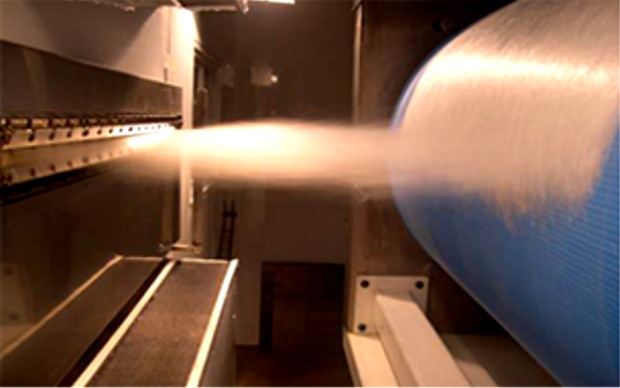 | ||
Melt blowing is a conventional fabrication method of micro- and nanofibers where a polymer melt is extruded through small nozzles surrounded by high speed blowing gas. The randomly deposited fibers form a nonwoven sheet product applicable for filtration, sorbents, apparels and drug delivery systems. The substantial benefits of melt blowing are simplicity, high specific productivity and solvent-free operation.
Contents
History
During volcanic activity a fibrous material may be drawn by vigorous wind from molten basaltic magma called Pele's hair. The same phenomenon applies for melt blowing of polymers. The first research on melt blowing was a naval attempt in the USA to produce fine filtration materials for radiation measurements on drone aircraft in the 1950s. Later on, Exxon Corporation developed the first industrial process based on the melt blowing principle with high throughput levels.
Polymers
Polymers with thermoplastic behavior are applicable for melt blowing. The main polymer types commonly processed with melt blowing:
Uses
Melt-blown fabrics have generally the same applications as other nonwoven products. The main uses of melt-blown nonwovens and other innovative approaches are as follows.
Filtration
The porous nonwoven melt-blown fabrics can be used in the filtration of gaseous as well as liquid materials. These applications include water treatment, masks, air conditioning filter, etc.
Sorbents
Nonwovens are capable to retain liquids several times of their own weight. For instance, polypropylene nonwovens are ideal to recollect oil contaminations.
Hygiene products
The high sorption efficiency of melt-blown nonwovens can be exploited in disposable diapers, sanitary napkins and other feminine hygiene products as well.
Apparels
The good thermal insulation properties, the barrier behavior against fluids combined with breathability make melt-blown nonwovens a great choice for apparels even in harsh environments.
Drug delivery
Melt blowing is also capable to produce drug-loaded fibers for controlled drug delivery. The high throughput rate (extrusion feeding), solvent-free operation accompanied with the increased surface area of the product make melt blowing a promising new formulation technique.
